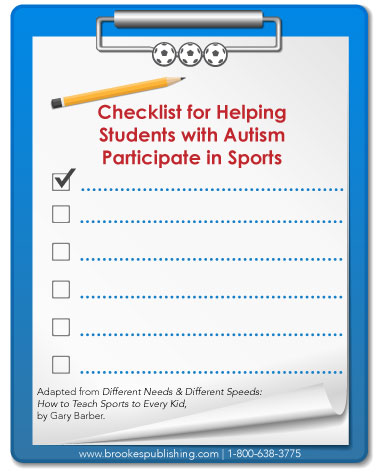7 Tips for Including Kids with Autism in Physical Education
August 23, 2016
Physical education classes are a great opportunity for fun, exercise, cooperative learning, and social skills practice for all kids, with and without disabilities. So what can you do if you’re a phys ed teacher looking to make your class more inclusive in the new school year—or a parent advocating for the full inclusion of a child with autism?
Today I’ll share some specific tips from Different Speeds & Different Needs author Gary Barber, a physical education teacher with more than 30 years of experience coaching kids with and without disabilities. Gary has real-world insights on how to include students with autism in physical education classes, strategies teachers can start using this year and parents can share with their child’s school. (It’s important to note that autism is a broad spectrum. Every student with autism is different, so what works for one child might not work for another. But these tips are a good starting point for a teacher getting started with inclusion.)
-
Presume competence.
Don’t assume that a child with autism isn’t interested in sports or fully capable of participating. Instead of adapting or simplifying the activity before a child gets a chance to try it, set realistic goals and teach the child to ask for help if she is struggling. This gives the student a powerful sense of achievement and responsibility.
-
Give visual cues.
Many children on the autism spectrum find change and uncertainty stressful, so learning is often easier when visual cues are provided. Try creating a visual schedule with drawings or photos to introduce your student to a sequence of activities, such as going to the locker room, changing into appropriate clothes, putting on sneakers, and lining up with classmates.
-
Keep instructions brief and clear.
Introduce new concepts to your class clearly, using visual demonstrations of the skills and movements you’re targeting. Keep instructions brief and to the point—the best way to teach your students with AND without autism!
-
Vary tasks.
An effective teaching method for many students with autism, the task variation technique is a good way to tell the brain “this is something important to learn and remember!” To try it, change activities frequently but revert to an important skill every few minutes. Gary Barber gives this example: in his running class, he wanted to teach his students to run with a bent elbow instead of a straight arm. He had his students apply that lesson first in a short practice run. Then he moved on to other lively running games like chase and tag—but returned to the “bent elbow” lesson briefly whenever students would revert to their old “straight arm” technique.
-
Address sensory challenges.
Some students on the autism spectrum have a heightened response to sensory input (smells, sound, touch) and can become overwhelmed by too much noise or visual stimuli. For students with sensory challenges, try calming supports such as squeeze balls, body belts that wrap around the waist, and mini trampolines.
-
Look for teachable (emotional) moments.
Every class period is filled with teachable moments, something you already know if you’re an experienced educator. Pay special attention to emotional experiences: share in the joy of a student who made her first basket, attend with empathy to a child who skinned his knee. Modeling these emotion-sharing skills will boost the social-emotional skills of all of your students, with and without autism.
-
Use special-interest rewards.
Does your student have special interests and fascinations? Many students on the autism spectrum do—and instead of trying to “put a lid” on these interest during classtime, you can use them as effective motivators. Find out what your student is interested in (the checklist below can help) and then use those things as small rewards for task engagement and appropriate behavior. You might also consider building games the whole class can enjoy around a child’s special interest. Everyone loves a game of Train Tag!
Ready to jump into phys ed inclusion—or expand the good work you’re already doing? This checklist from Gary Barber can help you get started. Click the button below the preview image to download it!

EXPLORE THE BOOK
 Gary Barber’s book, Different Speeds & Different Needs, also includes tips on inclusive physical education for students with other disabilities, plus general strategies on teaching diverse phys ed classes.
Gary Barber’s book, Different Speeds & Different Needs, also includes tips on inclusive physical education for students with other disabilities, plus general strategies on teaching diverse phys ed classes.




Write a Comment
Your email address will not be published. Required fields are marked *
comments
Alicia Venture says
Thank you for this inspirational article!
therapeutic school princeton nj says
Physical education may be challenging for children with Autism. These are 7 great tips on what you should do when teaching physical education for kids with Autism. Thanks for sharing.
rohit aggarwal says
thank you brookespublishing for giving me wonderful information
Post a Comment